I took advantage of the opportunity to chaperone Greg's high school German-language trip to Bavaria and the Alps in the spring of 2003, just as war was erupting in Iraq and SARS was breaking out in the Far East.
To prepare for our upcoming trip, I hired a retired German-language professor from a local university to eat lunch with me once a week for three months, and only speak in German. This refreshed my familiarity with the language, gained while working for Siemens, and stood in good stead throughout the actual trip.
We got together a couple of times before the trip, and the actual date approached, I volunteered to acquire some Euros for the travelers. After lots of rigmarole with a large travel agency in downtown Kalamazoo, it turned out that the main regional bank that serves this area offered the best deal overall. My advice: Look at both the exchange rate and service fees. Also, don't wait until the last minute, or processing fees will get you too. Even better, get cash from an ATM once you're on the ground.
As we got closer and closer to the trip, we also got closer and closer to the U.S. invasion of Iraq. With the ratcheting up of the terrorist alert levels, and the prospect of actual anti-American terrorist incidents in Europe, the school board got skittish, eventually withdrawing it's official stamp of approval from the trip. Fortunately, this didn't seem to impact most travelers' decision to continue with the trip.
There was also some (more reasonable) apprehension about how we, as Americans, would be treated in Europe. Personally, I thought it might be instructive to have the kids experience some anti-American sentiment in a fairly controlled environment. I checked with the Rick Steves' travel site, and with a friend who lives in Amsterdam, and concluded that if we followed some basic common-sense guidelines of conservative dress and polite behavior, we'd be fine. I forwarded the information I'd found to the school board and the trip organizer, who then distributed it to the families of the traveling kids.
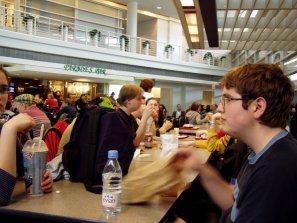 On the appointed day, the kids, their families, and the traveling adults all showed up at Kalamazoo/Portage airport, checked our baggage, and off we went.
On the appointed day, the kids, their families, and the traveling adults all showed up at Kalamazoo/Portage airport, checked our baggage, and off we went.
First stop - O'Hare International Airport in Chicago, where we changed from American to Swiss carriers, and from the domestic to the international terminal. We had a moment to get a snack and relax before departure.
As we settled into our seats on the Swiss Airbus, we discovered that each of us had our private LCD display, remote control, and phone. The more technically-oriented kids quickly figured out how to call each other across the plane by phone.
I'm not sure how much people slept; I didn't sleep more than a couple of hours on the 8-hour flight.
We arrived in Europe, transferring through Zurich to continue on to Vienna. We had a long wait in Zurich, and folks sat on the floor of the terminal, near a newspaper rack filled with blaring headlines about the conflict in Iraq. People came and went through the terminal, and most grabbed a copy. The German press was fairly critical of the war; the Swiss press was neutral. The French press was very negative, and the British press was fairly positive. More on this later.
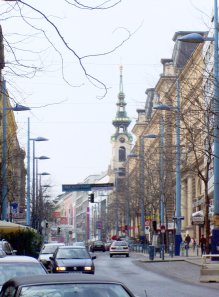 We arrived in Vienna to meet our cheerful guide Friedemann waiting for us. Luggage for most of us also arrived at the right time, but for a number of us, the long wait at the luggage carousel was unrewarded. Off we went to our hotel, in a neighborhood just west of the old Imperial center, just off Mariahilfestrasse, a bustling street named for one of the wives of an Austro-Hungarian emperor.
We arrived in Vienna to meet our cheerful guide Friedemann waiting for us. Luggage for most of us also arrived at the right time, but for a number of us, the long wait at the luggage carousel was unrewarded. Off we went to our hotel, in a neighborhood just west of the old Imperial center, just off Mariahilfestrasse, a bustling street named for one of the wives of an Austro-Hungarian emperor.
![[Image]](../Files_and_images/Fighting_Jet_Lag_in_Vienna.jpg) Friedemann wisely advised everyone to stay wide awake, to stave off the effects of jet lag. A brisk walk through the Imperial center to the shopping district near the St. Stephansdom (The Cathedral of St. Stephen) did just that. With an appointed meeting at a particular street corner some hours off, our group split into 3-4 person parties, each comprised of at least one boy, and many having a parent. Most of the small groups climbed the narrow spiral staircase up the steeple.
Friedemann wisely advised everyone to stay wide awake, to stave off the effects of jet lag. A brisk walk through the Imperial center to the shopping district near the St. Stephansdom (The Cathedral of St. Stephen) did just that. With an appointed meeting at a particular street corner some hours off, our group split into 3-4 person parties, each comprised of at least one boy, and many having a parent. Most of the small groups climbed the narrow spiral staircase up the steeple.
We walked back to our hotel, and noticed the rather frank attitude towards sexuality in Vienna, as evidenced by the gear and photographs in nearby shop windows. This was a topic of fascination for our sheltered Midwestern kids!
We congregated in the hotel lobby just before dinner, where Friedemann collected menu choices and called in our request to the restaurant nearby. The liver dumpling soup was a big hit, as was the Wiener schnitzel. For those less adventurous, spaghetti fit the bill. After dinner, everyone collapsed into their respective beds in their respective rooms.
We had hoped that our luggage would be waiting for us at the hotel, and a few pieces were, but for the rest of us, no such luck. The prospect of sleeping in and reusing underwear already used for 36 hours was not very appealing, but no alternative presented itself, since the next day was Sunday and shops were closed.
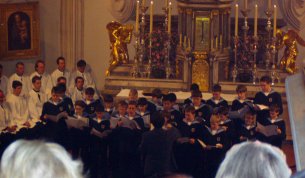 We started very early the next day with a lovely breakfast in the hotel, including wonderful Viennese hot chocolate. Our first event of the day was Mass at the Imperial Chapel, with the seven liturgical settings performed by the Vienna Choir Boys. I bought a program, which discussed the history and architecture of the chapel and the Vienna Boy's Choir, and provided notes for the (pretty obscure) composer. With the program, I got a copy of the music for the responsorial psalm and the Gloria, the only two settings in which the congregation was invited to participate (I did!).
We started very early the next day with a lovely breakfast in the hotel, including wonderful Viennese hot chocolate. Our first event of the day was Mass at the Imperial Chapel, with the seven liturgical settings performed by the Vienna Choir Boys. I bought a program, which discussed the history and architecture of the chapel and the Vienna Boy's Choir, and provided notes for the (pretty obscure) composer. With the program, I got a copy of the music for the responsorial psalm and the Gloria, the only two settings in which the congregation was invited to participate (I did!).
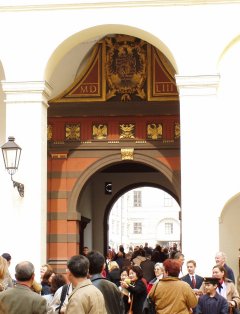 After Mass, we milled around the courtyard. The Imperial Chapel is situated above the Austrian treasury, which holds ancient artifacts of Christianity and the Austro-Hungarian Empire, including the spear point reputed to have been used by the Roman soldier to pierce Christ's side at the crucifixion.
After Mass, we milled around the courtyard. The Imperial Chapel is situated above the Austrian treasury, which holds ancient artifacts of Christianity and the Austro-Hungarian Empire, including the spear point reputed to have been used by the Roman soldier to pierce Christ's side at the crucifixion.
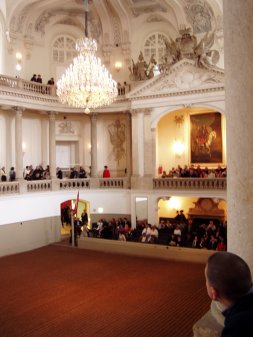 The Spanish Riding School is just across the courtyard from the chapel, and is the home of the Lippizanner stallions. We obtained standing-room-only admission, and enjoyed the spectacle of 90 minutes of magnificent horses, skilled riders, and wonderful music. I marveled at how the skills of war had been converted into this art form, and realized where the model of Da Vinci's horse had come from. As we were entering, a young woman snuck behind the ticket-taker, giving me a wry smile as she entered. Later, during the performance, I saw her make her way past me through the crowd, being pursued by officials of the school. I never saw her again.
The Spanish Riding School is just across the courtyard from the chapel, and is the home of the Lippizanner stallions. We obtained standing-room-only admission, and enjoyed the spectacle of 90 minutes of magnificent horses, skilled riders, and wonderful music. I marveled at how the skills of war had been converted into this art form, and realized where the model of Da Vinci's horse had come from. As we were entering, a young woman snuck behind the ticket-taker, giving me a wry smile as she entered. Later, during the performance, I saw her make her way past me through the crowd, being pursued by officials of the school. I never saw her again.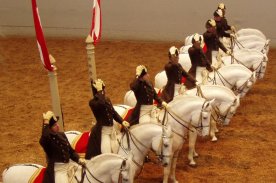
As we walked back to the hotel from the Spanish Riding School, we saw a number of people arriving and departing by carriage. What an exquisite way to see Vienna!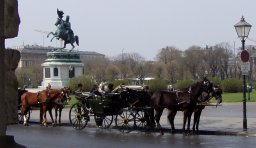
We were on our own to get a bite to eat before our afternoon guided tour of Vienna. As I walked down Mariahilfestrasse, I couldn't miss that icon of American culture, Starbucks. I had spinate-pizza (spinach pizza) at a small shop on the boulevard instead. The proprietor, a young man from Algeria, asked if I was American, and was very warm and friendly.
We had a formal tour guide for our afternoon, who provided running commentary on our bus trip around central Vienna and out to Schoenbrunn, the summer palace in the Vienna Woods. Vienna has grown up around the palace district, and the palace itself is a major tourist attraction for the area. Our tour guide, a suave and charming man in his 70's, yodeled to attract attention and gather us back together.
Schoenbrunn is overwhelming in its size and in the impression it makes on the visitor, as it was intended to do. Vienna was the center of Europe for centuries, and the palace, with its gold, marble, and alabaster appointments, makes this very clear.
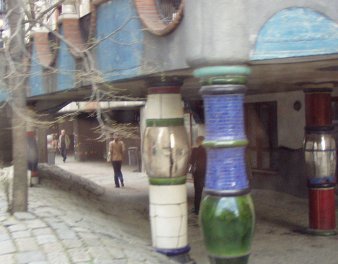 Vienna is a fascinating mix of old and new. Cathedrals and palaces built 500 or more years ago intermingle with the social architecture of Hundertwasser. The apartments occupied by Beethoven contrast with modern shopping districts and the Viennese headquarters of the United Nations.
Vienna is a fascinating mix of old and new. Cathedrals and palaces built 500 or more years ago intermingle with the social architecture of Hundertwasser. The apartments occupied by Beethoven contrast with modern shopping districts and the Viennese headquarters of the United Nations.
After our enjoyable bus tour of Vienna, we returned to the hotel to prepare for dinner at Wienerwald, or The Vienna Woods. The group was not quite so exhausted this evening, so after dinner, we took the subway to Prada, 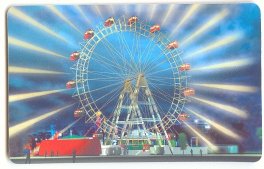 Vienna's venerable (read: seedy) amusement park, located on an island in the Danube River. Prada is famous for its Ferris Wheel, with large gondolas, each of which can hold 20 people.
Vienna's venerable (read: seedy) amusement park, located on an island in the Danube River. Prada is famous for its Ferris Wheel, with large gondolas, each of which can hold 20 people.
Upon returning from Prada, the rest of our luggage had arrived! Clean underwear at last!
 A good night's sleep prepared us for departing Vienna. The kids made good use of their time after breakfast while waiting to load the bus by playing cards
A good night's sleep prepared us for departing Vienna. The kids made good use of their time after breakfast while waiting to load the bus by playing cards
As our bus inched its way out of Vienna through the narrow streets, we listened to the waltzes of Johann Sebastian Strauss from my MP3 player piped through the bus's audio system. Soon, we were traveling westward along the north bank of the Danube, towards the Wachau Valley.
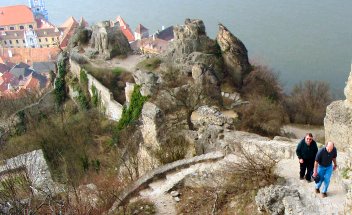 First stop was at Durenstein, where ruins of a castle dominate the hillside above the town. Richard the Lionhearted was held for ransom on this hill after returning from the Crusades. The bus pulled up to the small village on the banks of the Danube. Some kids, with bounding energy trapped by the 45-minute bus ride, started up to the top of the hill immediately; others of us took a more sedate pace to the top. In any case, the view was spectacular, making this one of my favorite stops on the trip.
First stop was at Durenstein, where ruins of a castle dominate the hillside above the town. Richard the Lionhearted was held for ransom on this hill after returning from the Crusades. The bus pulled up to the small village on the banks of the Danube. Some kids, with bounding energy trapped by the 45-minute bus ride, started up to the top of the hill immediately; others of us took a more sedate pace to the top. In any case, the view was spectacular, making this one of my favorite stops on the trip.
![[Image]](../Files_and_images/Cathedral_at_Melk.jpg) On another bend of the Danube a few miles west, the Abbey at Melk dominates the village below. The difference is that Stiftmelk, or Gift to Melk, is very much occupied. The abbey has been rebuilt several times after human and natural calamities, and still houses the magnificent library with tens of thousands of volumes dating back to the Dark Ages. The cathedral is aglitter with gold leaf and magnificent jewel-encrusted reliquaries and altar goods, having been recently been carefully restored to celebrate the 900th anniversary of the founding of the abbey.
On another bend of the Danube a few miles west, the Abbey at Melk dominates the village below. The difference is that Stiftmelk, or Gift to Melk, is very much occupied. The abbey has been rebuilt several times after human and natural calamities, and still houses the magnificent library with tens of thousands of volumes dating back to the Dark Ages. The cathedral is aglitter with gold leaf and magnificent jewel-encrusted reliquaries and altar goods, having been recently been carefully restored to celebrate the 900th anniversary of the founding of the abbey. ![[Image]](../Files_and_images/Library_at_Melk.jpg) The inscription over the main altar, "Non Coronabitur Nisi Legitime Certaverit," translates to "Without a legitimate conflict there can be no victory" or "For no one is crowned except he who has striven lawfully," perhaps a reference to the Reformation that swept through the Danube Valley in the mid Sixteenth century, and the re-emergence of Catholicism in the Counter-Reformation a century later.
The inscription over the main altar, "Non Coronabitur Nisi Legitime Certaverit," translates to "Without a legitimate conflict there can be no victory" or "For no one is crowned except he who has striven lawfully," perhaps a reference to the Reformation that swept through the Danube Valley in the mid Sixteenth century, and the re-emergence of Catholicism in the Counter-Reformation a century later.
Ah, Salzburg!
We arrived late in the afternoon in Salzburg. Upon leaving the highway, we drove through modern roads full of automobile dealerships, Chinese restaurants and pizzerias. "How can this be the cradle of Classical music?" I wondered.
![[Image]](../Files_and_images/Friedemann.jpg) On a quiet side street away from the hustle and bustle of the main road, the Hotel Dr. Schlossel presented its calm facade to the weary travelers. We ate a nice, but quick dinner in the hotel's arched dining room, settled into our rooms for a moment, and then convened in the courtyard outside the buildings for a walk to unwind.
On a quiet side street away from the hustle and bustle of the main road, the Hotel Dr. Schlossel presented its calm facade to the weary travelers. We ate a nice, but quick dinner in the hotel's arched dining room, settled into our rooms for a moment, and then convened in the courtyard outside the buildings for a walk to unwind.
Our destination was the home that Baron von Trapp built to accommodate his new bride, Maria, and his children from a previous marriage. Perhaps the Rogers and Hammerstein film, The Sound of Music, didn't mean as much to a generation of kids who'd learned about Salzburg through "Amadeus!" but it was still fun to walk through the neighborhoods, pedestrian tunnels under railways, and into the street where the Trapp Family lived. Our group of two dozen or more arrived outside this (currently occupied) home well after dark, and as the camera flashes illuminated the house, the window shades were quickly drawn.
Friedemann led our way back to Hotel Dr. Schlossel. We passed a chalet at the top of a beautiful sloping lawn, and a cemetery in which numerous votive candles flickered mysteriously in the darkness of the late evening. Our quiet walk back to the hotel past the cemetery is one that I'll remember for the rest of my life.
![[Image]](../Files_and_images/Seminary_and_Cemetary.jpg) After a quick breakfast, our formal tour of Salzburg began. Our bus driver dropped us all off near Salzburg's municipal gardens, from which we could see the imposing edifice of the castle on Hohensalzburg (Upper Salzburg) across the river in the distance. We walked past and through sculptures, fountains, and gardens as we made our way past the Mozart family home (or at least a modern reconstruction of it), then crossed the pedestrian bridge to the old city. The narrow streets and covered alleys of the old city were full of cars and delivery vehicles that all magically disappeared at 10:00 a.m. Our tour guide showed us the historic buildings, cathedrals, seminaries, and castles. He pointed out the buildings that comprised the venues for the Salzburger Festspiele and other major cultural events that operate continuously here.
After a quick breakfast, our formal tour of Salzburg began. Our bus driver dropped us all off near Salzburg's municipal gardens, from which we could see the imposing edifice of the castle on Hohensalzburg (Upper Salzburg) across the river in the distance. We walked past and through sculptures, fountains, and gardens as we made our way past the Mozart family home (or at least a modern reconstruction of it), then crossed the pedestrian bridge to the old city. The narrow streets and covered alleys of the old city were full of cars and delivery vehicles that all magically disappeared at 10:00 a.m. Our tour guide showed us the historic buildings, cathedrals, seminaries, and castles. He pointed out the buildings that comprised the venues for the Salzburger Festspiele and other major cultural events that operate continuously here.
After the formal part of our tour completed with a tour through the Mozart family home back across the river, we had unscheduled time to roam through the city, meeting the bus back near the gardens before dinner. I wandered through the old city for hours. The Old City is definitely a tourist destination, with numerous boutiques offering the loveliest food, clothing, jewelry, and accessories. I stuck to the street vendors' wares, and ate my lunch of fresh cheese, baguette, chocolate, a pear and a banana while walking from stall to stall.
I was dressed very conservatively during my walk through the Old City - black slacks, dark grey suede shoes, a dark grey turtleneck and fleece zip-up pull-over. I was thrilled when storekeepers and passersby initiated conversations in German - I had become invisible in the culture!
![[Image]](../Files_and_images/Old_City_from_Hohensalzburg_-_Small.jpg) Most of our party met in one of Salzburg's many plazas later in the afternoon, and climbed to the top of Hohensalzburg - a brisk effort that left most of us breathless. This made very clear the rationale for building castles at the top of hills - I can just imagine what it would be like trying to climb the causeway to the castle with 150 lbs. of armor, weapons, and other gear during invasion attempts. The trip back down was much quicker!
Most of our party met in one of Salzburg's many plazas later in the afternoon, and climbed to the top of Hohensalzburg - a brisk effort that left most of us breathless. This made very clear the rationale for building castles at the top of hills - I can just imagine what it would be like trying to climb the causeway to the castle with 150 lbs. of armor, weapons, and other gear during invasion attempts. The trip back down was much quicker!
I made a couple of exceptions to the "no boutique" rule when I bought my wife and daughter matching boiled wool "tracte" (traditional) sweaters - a big hit when we returned home.
We ate another nice dinner back at the hotel, and then we had an evening of unplanned activities. Friedemann (or fearless tour coordinator) and our teachers decided that Salzburg was small enough, and the kids mature enough, to set them loose in the Old City with some rules: first, all groups were to be co-ed, no groups were to be smaller than 3 people, and the groups were to make their own way back to the hotel that evening.
While we were preparing for our evening outing, a bus-load of students from China arrived, and started to unpack just amazing amounts of baggage. They quickly made their way through registration, and noisily up to their rooms. The water pressure immediately dropped throughout the hotel.
Cindy, another parent chaperone, her son Derek, and I had bought tickets for a chamber music performance in Hohensalzburg that evening, and because we had a tight schedule, the bus dropped us off first. We ran to the tram for our ride to the top of Hohensalzburg. On the tram, we met a group of four middle-aged men from the Netherlands. One wore a U.S. flag lapel pin, and was just one of the many people I met who commented positively about our presence in Europe, and also positively about America's role in the world. He said that the U.S. had "kicked the Nazis out of the Netherlands" during World War II, and also said that he believed that "America's heart is in the right place."
Once we got back to the hotel after the concert, I started looking for kids from our group to make sure that they'd made it back from the Old City all right. A number had arrived by the time we got there, and the rest returned over the next hour or so. I sat in the lobby area for much of that time, greeting the kids from our group as they came in and quietly returned to their rooms. While sitting there, there was quite an audible ruckus from the other group that had arrived while we were out wandering around. Their tour leader arrived in the lobby, and asked the innkeeper for hot water. He walked her over to the kitchen and presented her with a pitcher of hot water from a kettle on the stove. She loudly complained that that wasn't what she meant - that the hotel had run out of hot water. She got more and more insistent, and louder and louder in her complaints. Finally, the innkeeper - in a very non-Bavarian demonstration of temper - replied that her group had taken multi-hour-long showers in every room they occupied, and that the other group (ours) wasn't even in the hotel that evening, so if there was anyone to complain about, it was her own group. He then suggested that if this situation wasn't satisfactory, that her group could pack up and leave the hotel immediately. Some time later I visited the innkeeper and asked if all the keys for our rooms had been claimed - just to make sure everyone was back - and thanked him for his hospitality. He looked me straight in the eye and thanked our group for their courtesy, and wished that all students from Portage High Schools to visit Salzburg and stay at his hotel. He said that our group was wonderful, and that he wished that all groups could be as pleasant as ours. Wow!
![[Image]](../Files_and_images/Salt_Mine_Ticket_-_small.jpg)
![[Image]](../Files_and_images/At_the_Salt_Mine.jpg) We packed up and left Salzburg early the next morning on our way to Munich. Our first stop after a brief bus ride was one of the salt mines (Salzburg means "salt mountain") nearby. We found this mine closed, but were able to observe Hitler's "Eagle's Nest" in the hills above. We traveled to the other salt mine nearby, where we met our wonderful tour guide at the entrance. She had been born in the town nearby, and as a child, had traveled throughout the United States and the world while her parents were on the road crew for the Harlem Globetrotters. She was humorous, warm, and very informative about the salt mine. Everyone had a great time on the wooden slides that separated the levels of the mines, and the ferryboat that carried us across the underground lake in the mine.
We packed up and left Salzburg early the next morning on our way to Munich. Our first stop after a brief bus ride was one of the salt mines (Salzburg means "salt mountain") nearby. We found this mine closed, but were able to observe Hitler's "Eagle's Nest" in the hills above. We traveled to the other salt mine nearby, where we met our wonderful tour guide at the entrance. She had been born in the town nearby, and as a child, had traveled throughout the United States and the world while her parents were on the road crew for the Harlem Globetrotters. She was humorous, warm, and very informative about the salt mine. Everyone had a great time on the wooden slides that separated the levels of the mines, and the ferryboat that carried us across the underground lake in the mine.
![[Image]](../Files_and_images/Asleep_on_the_bus.jpg) As we traveled westward towards Munich, the sky closed in and snow started to fall. We ate lunch at a road-side rest area, and slept for the next couple of hours. The group emerged from slumber as the bus circled Munich and approached Dachau.
As we traveled westward towards Munich, the sky closed in and snow started to fall. We ate lunch at a road-side rest area, and slept for the next couple of hours. The group emerged from slumber as the bus circled Munich and approached Dachau.
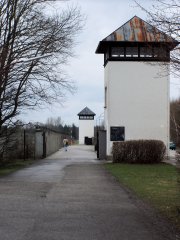 At Dachau, the explanation of the historical context of the rise to power of the Nazis and Fascists was excellent, and chilling in its parallels to current events (establishment of secret courts by emergency decree, the inability of the democratic process to clearly indicate a winner in the election of the chancellor, extraterritorial imprisonment, torture, and murder of enemies of the state to avoid civil rights entanglements, re-definition of what it meant to be a "member of society"). We all left Dachau in a very somber mood.
At Dachau, the explanation of the historical context of the rise to power of the Nazis and Fascists was excellent, and chilling in its parallels to current events (establishment of secret courts by emergency decree, the inability of the democratic process to clearly indicate a winner in the election of the chancellor, extraterritorial imprisonment, torture, and murder of enemies of the state to avoid civil rights entanglements, re-definition of what it meant to be a "member of society"). We all left Dachau in a very somber mood.
(When I originally wrote this, in 2003, I expressed the hope that, without sufficient information to truly know what is going on, all I could, do was hope that our leaders knew what the hell they were doing. In retrospect, it appeared that they didn't.)
We arrived in downtown Munich a half-hour later, having driven past the site of the 1972 Olympics, past the BMW headquarters, and toward the pedestrian-only area. Again, our skillful bus driver negotiated the narrow streets and tight turns, depositing us in front of our hotel. The exterior of the hotel was cluttered with a vegetable and fruit-seller's stands. After settling in for a half-hour or so, Friedemann conducted us to the Rathskeller, a restaurant in the basement of the famous beer hall in the center of Munich. Our group was not the loudest there by any stretch of the imagination!
When we left the Rathskeller after dinner, various groups split up and wandered around. Friedemann and I wandered through the beer hall part upstairs while others bought souvenirs nearby. The rowdy crowd was singing "Tie a Yellow Ribbon 'Round the Old Oak Tree" - it sounds really strange with a strong Bavarian accent! I had no alternative but to join in. We wandered around for a while longer, then back to the hotel. By the time we got back, long after dark, the fruit and vegetables were gone.
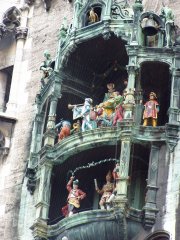 Our expedition the next morning took us back into the center of Munich.
Our expedition the next morning took us back into the center of Munich.
We had seen a pavilion set up in the plaza outside the Rathskeller, underneath the famous story-telling clock in its tower. There were anti-war slogans plastered prominently over the entrance and around the sides. One of our teachers entered the pavilion, stood in line behind two German women - one about 25, the other about 70. When they got to the front of the line, the young woman asked to sign the anti-war petition, but the older woman pushed ahead of her and demanded to sign the pro-war petition. The people behind the table, and many of the people nearby, stared at her incredulously. Then she said that if the Americans had done for Germany in the '30's what they were doing for Iraq then, Hitler would never have risen and the course of history would have been changed. We stood there, taking all this in, and related it to the students immediately afterwards.
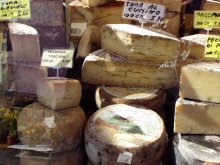 Prior to our visit to the main museum, we all wandered around the farmer's market downtown. I stopped in at a cheese shop, and struck up a conversation with the shopkeeper. She was very happy that our group was visiting Munich and Europe, and said that not all Germans were against the war. She was very surprised when I told her that about a third of the homes on our street in Michigan had anti-war placards on their lawns. We both commiserated over the inaccurate pictures both countries' media were painting.
Prior to our visit to the main museum, we all wandered around the farmer's market downtown. I stopped in at a cheese shop, and struck up a conversation with the shopkeeper. She was very happy that our group was visiting Munich and Europe, and said that not all Germans were against the war. She was very surprised when I told her that about a third of the homes on our street in Michigan had anti-war placards on their lawns. We both commiserated over the inaccurate pictures both countries' media were painting.
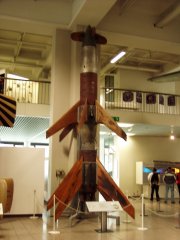 The museum was weird - lots of emphasis on science and engineering, including both V-1 buzz-bomb and V-2 rocket, but virtually no mention of Nazism's influence in their development and use.
The museum was weird - lots of emphasis on science and engineering, including both V-1 buzz-bomb and V-2 rocket, but virtually no mention of Nazism's influence in their development and use.
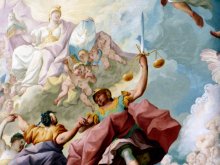 Later that afternoon we had a bus tour of Munich and a walk through Nymphenburg Palace, which after Schoenbrunn was somewhat of a letdown. I enjoyed the concept of the Gallery of the Beauties - Ludwig the 1st's equivalent of a 20th century cheescake calendar, I suppose.
Later that afternoon we had a bus tour of Munich and a walk through Nymphenburg Palace, which after Schoenbrunn was somewhat of a letdown. I enjoyed the concept of the Gallery of the Beauties - Ludwig the 1st's equivalent of a 20th century cheescake calendar, I suppose.
Dinner that night was at the Augustiner Brauerei, a very traditional brewery restaurant some distance from our hotel. After a long walk, we were particularly hungry and thirsty - good thing they had lots of beer there! We had a much shorter walk back to our hotel - I guess Friedemann was helping us enjoy the view of Munich "from the street", as it were, on our way there.
We left Munich and drove quickly into the Alps, where we visited Neuschwanstein, "Mad Ludwig's" fairy-tale castle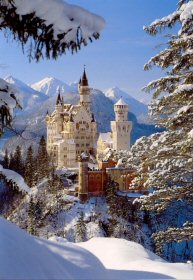 . It had started to snow as we approached. By the time we arrived, the forest was dusted with snow. The climb up to the castle was lovely, and we were early enough to avoid the press of crowds more typical of weekends, summer, and afternoons. The English-language tour was very efficient, showing us through this set-piece of mythology, opera, and ejecting the tour groups into the castle's gift shop. I bypassed the giftshop and joined Friedemann and our bus driver at a restaurant halfway down the mountain. We enjoyed porkchops and applesauce, and I continued to practice my German language skills.
. It had started to snow as we approached. By the time we arrived, the forest was dusted with snow. The climb up to the castle was lovely, and we were early enough to avoid the press of crowds more typical of weekends, summer, and afternoons. The English-language tour was very efficient, showing us through this set-piece of mythology, opera, and ejecting the tour groups into the castle's gift shop. I bypassed the giftshop and joined Friedemann and our bus driver at a restaurant halfway down the mountain. We enjoyed porkchops and applesauce, and I continued to practice my German language skills.
The sun had emerged and melted the snow when we got back on the road. We traveled south into Austria, then west towards Switzerland.
 The philatelists in the group were thrilled when we stopped briefly in Vaduz, Liechtenstein, between Austria and Switzerland. Friedemann arranged for us all to have visa stamps in our passports, and while people wandered around, Friedemann and I enjoyed a capuccino in a cafe nearby.
The philatelists in the group were thrilled when we stopped briefly in Vaduz, Liechtenstein, between Austria and Switzerland. Friedemann arranged for us all to have visa stamps in our passports, and while people wandered around, Friedemann and I enjoyed a capuccino in a cafe nearby.
Liechtenstein is only about 10 miles wide and 40 miles long, so it didn't take very long at all to leave the country and enter Switzerland, a land of spectacular mountains, beautiful lakes, and small, well-kept cities. About an hour later we left the highway, drove through the small town of Zug past herds of cattle, and then into Lucerne. Little did I know that I'd spend quite a bit of time in Zug over the next decade or so, on behalf of Amgen.
The evening we arrived in Lucerne we ate dinner at a nondescript little restaurant near the hotel, made even more nondescript by the bland menu we were served - pizza, milk, and ice cream. We wandered back to the hotel, and crashed.
The next morning we took a walking tour through the central city, strarting with a brisk walk over the covered bridges to the American Express office, where cash was replenished by those of us who hadn't brought ATM cards. We continued on to the Lion of Lucerne sculpture made famous by a quote in Mark Twain's A Tramp Abroad. Once through the walk, we were free to explore on our own, to meet back at the hotel by noon. Many of the kids went with Friedemann to stock up on Swiss Army knives and other paraphenalia at a shop near the train station. I split off, found a model train shop and picked up a Märklin catalog for my father-in-law, an avid HO train collector. I wandered through neighborhoods to get a better feel for the city, found a music instrument shop and a very nice bookstore, then wandered back through the covered bridge area to the open-air market, where I assembled an inexpensive but delicious lunch of a baguette, some dates, a nice piece of cheese, and a capuccino.
I met back up with the group in time to catch the articulated city bus to the Mount Pilatus Gondola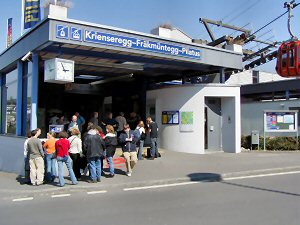 , which took us to the bottom of the mountain, and the lowest stop of the lengthy gondola ride to the top
, which took us to the bottom of the mountain, and the lowest stop of the lengthy gondola ride to the top. The adults and kids split up among numerous gondola cars, rejoined briefly at the stop one-third the way up to change to the next gondola system, and then we all toured the conference center and walkways at the snowy peak of Mount Pilatus.
In 2007, I had the opportunity to re-visit Pilatus, by way of the water taxi from Lucerne, and cog-rail train to the top. On that trip, I hiked down the lower two thirds to the bus stop at the bottom.
We returned from our Pilatus trip, spent a few minutes freshening up, and then walked through the old city to Swiss Restaurant Lucerne, a restaurant / beer hall, where we were all seated at a long table oriented towards an empty stage. We were soon stuffed with wonderful authentic Swiss food (far better than the pizza and ice cream the previous night), and other tables began to fill. As the population rose, so did the noise level, with an enthusiastic restaurant staff cheerfully contributing their fair share. As we settled in to dinner, the staff also conveyed requests and messages from table to table, which is how we happened to meet other visitors from Japan, elsewhere in the United States, etc. This convivial atmosphere persisted through a pleasant dinner.
The hostess made her way to the podium on the stage, where she announced that a program of traditional Swiss folk entertainment would soon begin, and that in addition to the restaurant staff, we were expected to join in at the appropriate times. We weren't quite prepared for the extent of audience participation, but all worked out well.
A young woman came to the podium, and sang some folk songs, accompanying herself with a zither, followed by another young woman singing and accompanying herself with a beer-bottle xylophone - delightful!
A couple of men, and the hostess, came to the podium, and accompanied their singing by swirling ball-bearings in ceramic bowls - weird (except this "instrument" is featured in Andreas Vollenweider's music).
Then, the hostess came to the podium, and with the others, did some spectacularly complicated yodelling - wow! The hostess then started pointing out people in the audience to come up and try yodelling, and I was volunteered by the kids. When I got to the podium, I had had a chance to listen to the tune five or six times, and asked the hostess to yodel, with me singing harmony. It worked! I bowed to the audience's applause, and returned to my seat.
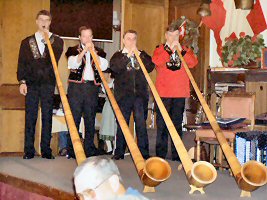 After the yodelling, the young men returned, with immense Alpenhorns, and through their skills and experience, played some deep, tuneful melodies. The hostess started pointing out 'volunteers' from the audience again, and this time, our ringer Cindy, volunteered. Cindy, a French Horn player with the Kalamazoo Symphony, comported herself quite honorably indeed, getting a standing ovation from the audience and peals of pleased laughter from the staff.
After the yodelling, the young men returned, with immense Alpenhorns, and through their skills and experience, played some deep, tuneful melodies. The hostess started pointing out 'volunteers' from the audience again, and this time, our ringer Cindy, volunteered. Cindy, a French Horn player with the Kalamazoo Symphony, comported herself quite honorably indeed, getting a standing ovation from the audience and peals of pleased laughter from the staff.
After that high point, we walked across the bridges back to our hotel, and prepared for our trip home.
We all arose very early the next morning, stumbled onto the bus, and drove north to Zurich, the airport, and a long flight home. What a wonderful trip!
My work at Amgen took me back to the area often. When these travels began, Amgen's European HQ was in Lucerne; by the time I was done, the HQ had moved to Zug.
It's quite amazing for an American to get on a plane in Los Angeles, step off the plane in Zurich, collect bags, and immediately catch a train to Lucerne or Zug, step off the train, and into the hotel, in a small city nestled in the mountains. I arranged meetings such that I'd spend the weekend, biking around Lake Lucerne, taking the cog-wheel train to the top of Mt. Pilatus and hiking down, seeing Andreas Vollenweider in concert in a tiny theater, and going hiking in the alpine meadows above Zug.
I joined a Meetup hiking group in Zurich for two hikes, and was required to purchase Swiss Mountaineering insurance. About $40, and it covered mountain rescues anywhere in the country. What a great idea!
On my very last trip, my contacts rescheduled it so many times that the fare plus change fees soon exceeded the first class fare, so I flew to and fro in first class on Swiss - a great experience.
Last Updated February 02, 2024